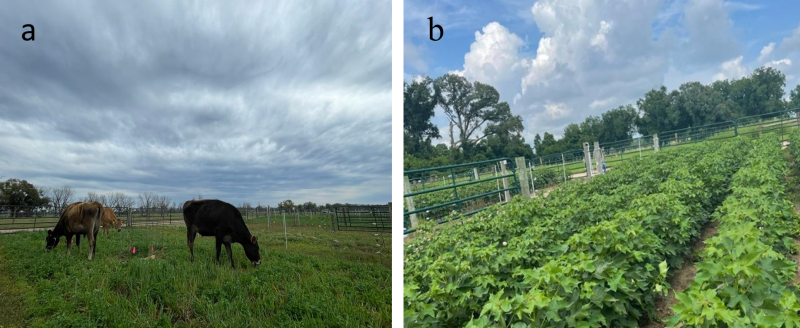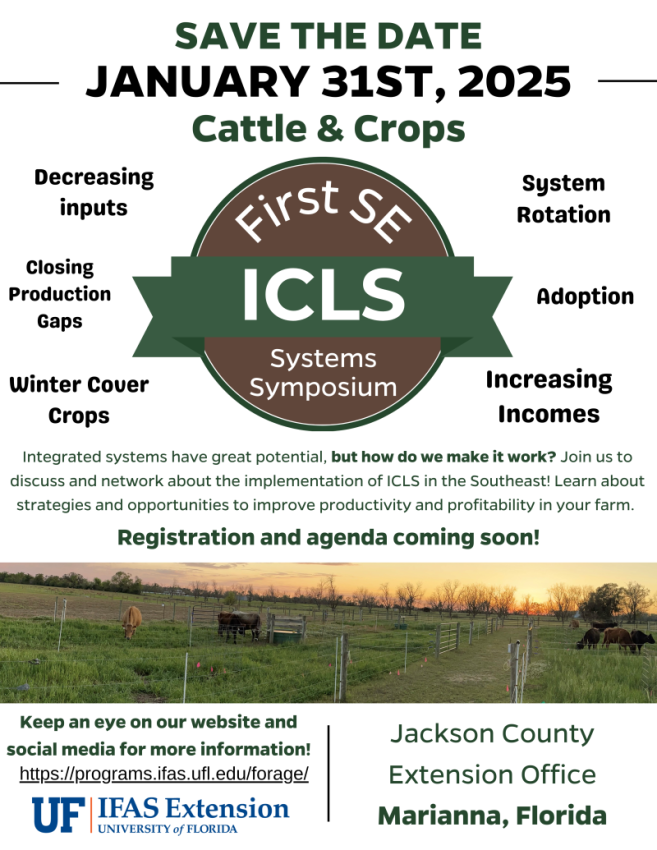
Animals grazing cover crop during cool season (a) and cotton planted in the following summer (b) in the same field in an integrated crop and livestock system in North Florida. Photo credit: Luana Queiroz, UF/IFAS
Marcelo Wallau, Ashley Kuhn, Alejandro Ruden, and Emanuel Cassol Dall’Agnol, UF/IFAS Agronomy Department
Cattle and crops are part of the livelihood and the culture of southern folks. They are ingrained in our history and integrated in the landscape, coexisting through large areas of rural U.S. However, this integration is not complete. Cattle stand on one side of the fence, while crops grow on the other – some might even say that row crop farmers and cattle ranchers don’t always see eye to eye. Much of this cropland, however, lies fallow for part of the year when it could be productive. Meanwhile, many cattlemen feed hay during the winter, which adds to production costs. What if we combined our efforts?
The integration of crops and livestock is not a new idea. In fact, it dates back to the beginnings of agriculture when cattle provided manure and labor for crop production. With technological advances, the availability of cheap fertilizers, and the specialization of production systems, we moved away from this integration, focusing on a few crops. While farm output has increased exponentially, so has the reliance on a single commodity. Farms in the early to mid-1900s typically produced between five and ten different commodities, including both livestock and crops. Nowadays, most farms rely on just one or two main commodities.
The climate and production system in the southeastern United States are well suited for the integration of crops and livestock. When the cotton, peanut, or corn are harvested, a new crop of oat, rye, triticale or ryegrass can be planted. The winter forage can be grazed through the winter, and then the land prepared again in the spring for the next agronomic crop in the rotation. Best of all, it is likely the cattle are just next door. There are many benefits to this approach. First, it diversifies commodities, which can increase income and reduce dependence on a single source. Second, it improves soil health, recycles nutrients, and reduces nutrient losses to water bodies – saving money and boosting productivity. Third, it can help the younger generation return to farming through leases, partnerships, or by creating new business opportunities within family farms.
Our research has shown that the perceived negative impact of grazing, often called the “hoof effect,” is a myth tied to poor management. We’ve also demonstrated that crop production can increase in integrated systems, and that animal performance on winter pastures can surpass that of hay feeding—at a lower cost. Moreover, these systems help achieve conservation goals and earn best management practice credits. Despite these advantages, adoption of such systems remains low, and we want to understand why. How can we make Integrated Crop-Livestock Systems (ICLS) work? To answer that, we need to listen to the experts—the farmers and ranchers.
That’s why we are gathering this coming January 31st, 2025, with colleagues and practitioners for the first SE Symposium on Integrated Crop Livestock Systems in Marianna, FL. Our goal is to talk cattle and crops and discuss implementation strategies and management practices to make ICLS work. We’re assembling a roster of top-notch speakers to cover agronomics, economics, marketing, and partnerships, including real-world examples from those who are already making it happen. Our roundtable will feature distinguished producers from whom we learn every day about effective management.
There is a great opportunity to enhance revenue and improve efficiency of land and resource use in our region. Mark your calendars and keep an eye on our social media and Forage Team website for more information. The agenda will be available soon.
- UF/IFAS 2025 Top Rancher Challenge Showcases Youth and Adult Talent - July 11, 2025
- Cow Talks: Special Guests Discuss the Impact of H5N1 Avian Influenza on Agriculture - April 25, 2025
- Why is this weed here? Weed Management in Pasture Systems - February 28, 2025

